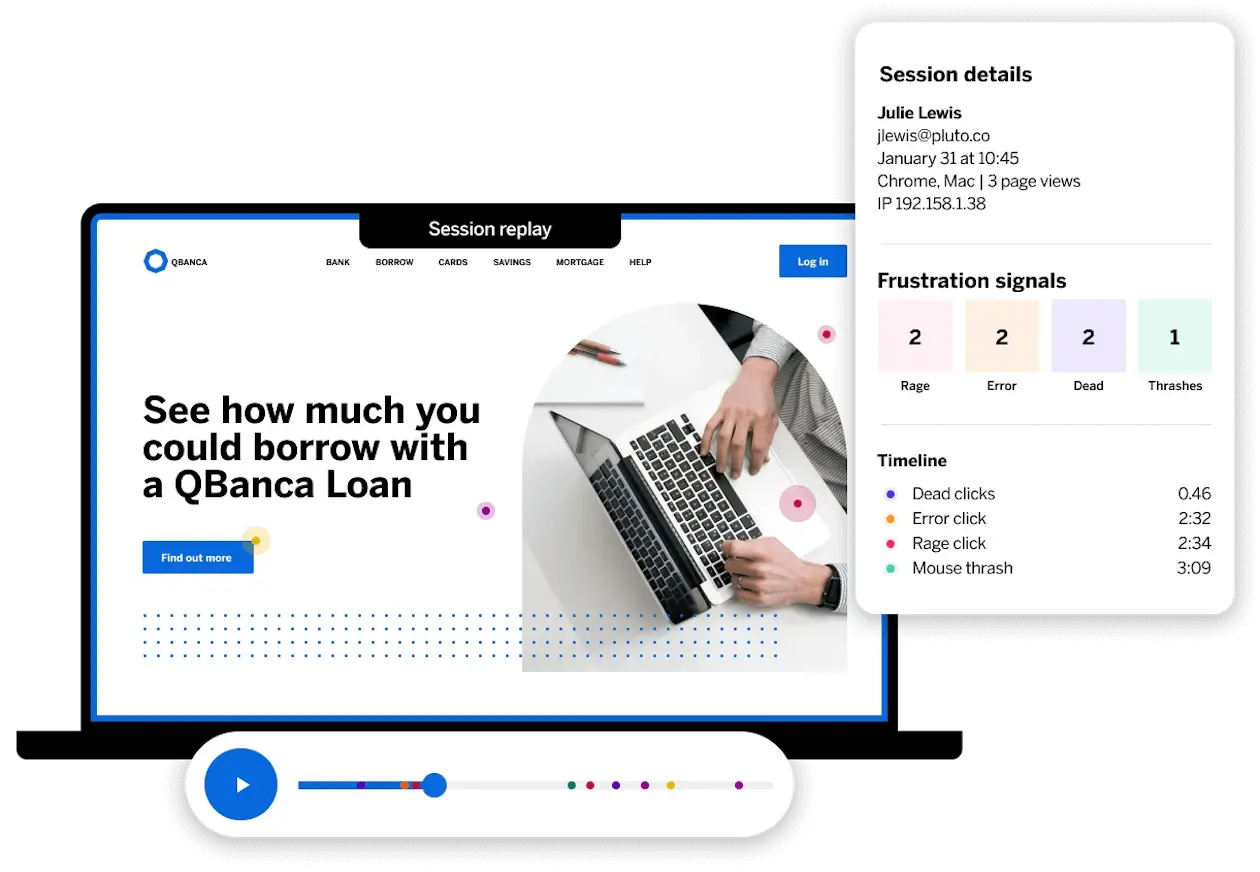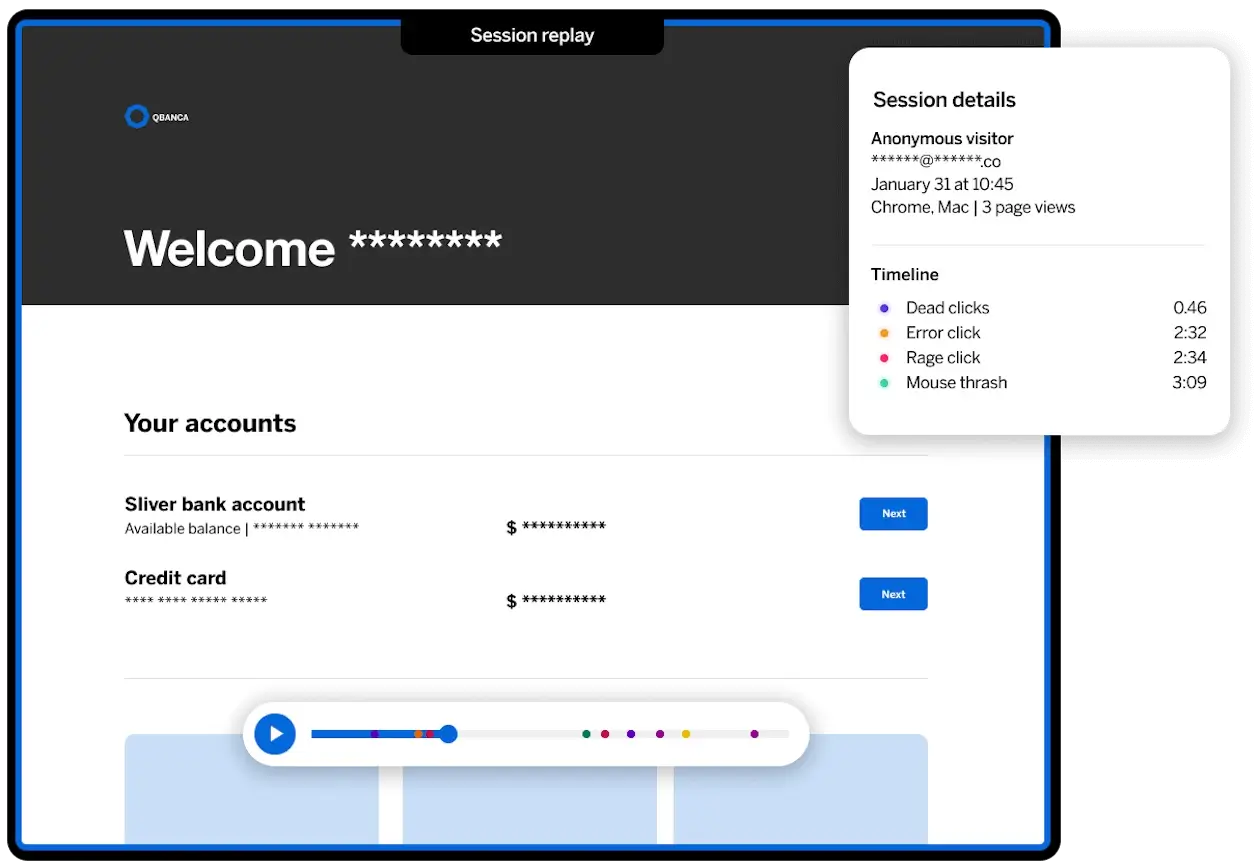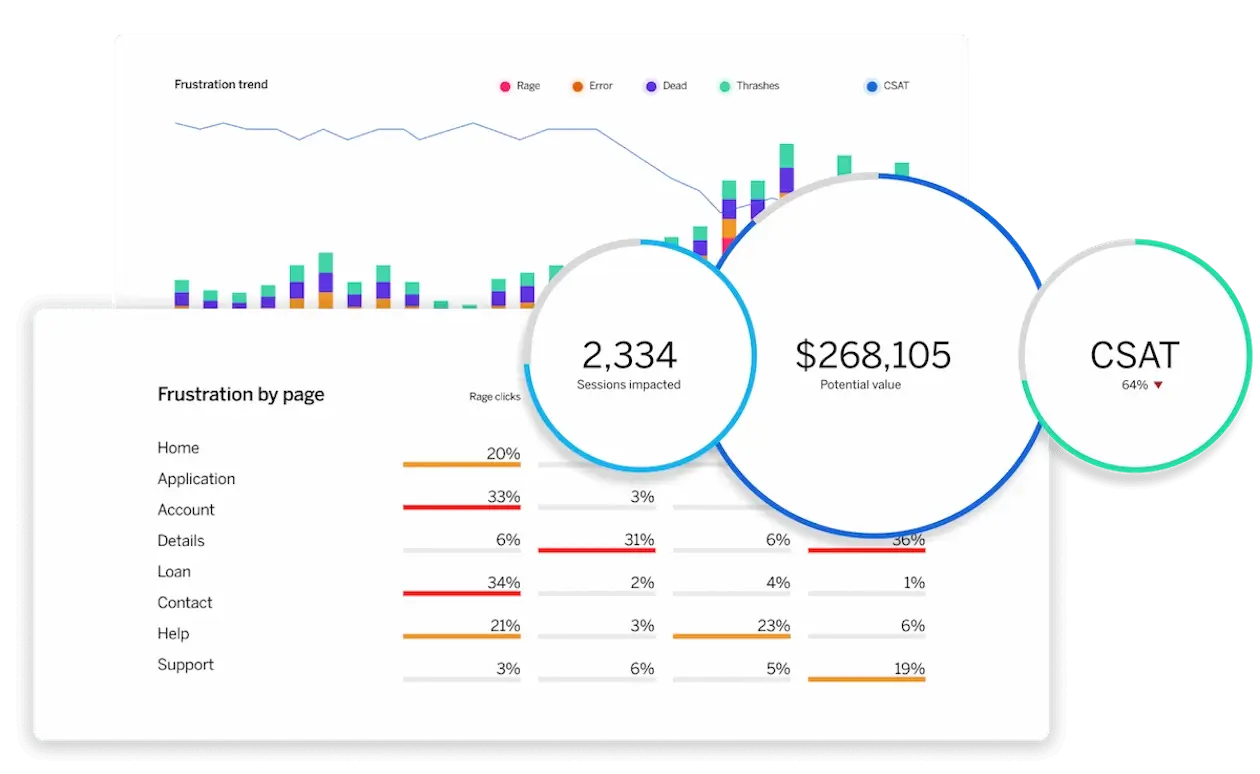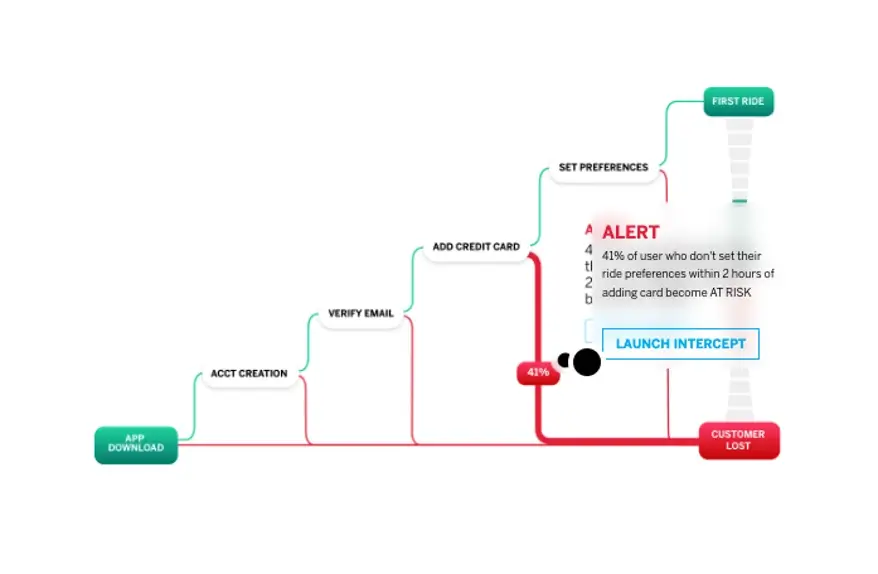What is session replay?
Session replay is a type of software solution that lets brands reproduce a user’s journey on websites, products, or mobile apps. Because these reproductions are visual – including things like mouse movements, scrolls, and clicks – session replay tools provide incredibly useful behavioral and experiential data that can be used to make website or app improvements.
Session replay tools let brands recreate, understand and solve issues by tracking common indicators of frustration found during user sessions. Alongside tracking the actual movement of the mouse throughout the customer journey, when you watch session replays, you’ll normally be presented with analytics around a few common activities:
Rage clicks
This is when a user interacting with your site clicks or taps the same area multiple times in a short spell, indicating that something either hasn’t worked or is taking too long.
Mouse thrashes
A mouse thrash is when the user moves their cursor back and forth quickly in irritation – again, this is usually because something has taken too long, or doesn’t what they expected
Error clicks
An error click is logged when the action doesn’t have the expected result, like a button not working, or a link being broken.
Dead clicks
Dead clicks are clicks on items of page furniture that have no interactive elements to them. Usually, this represents a UI misunderstanding, where a customer thinks something decorative is a button or will lead somewhere.

The goal of using session replay is to get a better understanding of user behavior and to identify where things are holding them up, or causing the customer journey to fall apart. This experience data is vital when it comes to building the kind of user journey flows that customers expect.
Put simply, session replay helps product managers, customer support agents, and marketing teams answer the following three questions:
- What are my customers trying to achieve?
- Are they able to achieve it easily?
- If not, why?
Identify frustrations and errors on your site with Digital Experience Analytics
How session replay works
Session replay works by logging ‘events’, and turning those events into a reconstruction. Every time a user moves their mouse over a website element clicks a button, or taps a link, that event is logged in the session replay software.
After the fact, all those events are pieced together in order, to form a visual recreation of that user’s journey around your site or app.
A good analogy for this is LEGO. Imagine we sit you down to make something out of LEGO bricks, and every time you snap two blocks together, we make a note of it. After you’ve left, if we then gave all those notes to someone else, they’d be able to faithfully recreate your creation in the exact same order – even if they couldn’t see you make it at the time.
What session replay doesn’t do
Even though you might often see ‘session recordings’ being used as a term in this field, a session replay isn’t actually a video recording. In other words: when brands use session replay tools, they’re not recording a user’s computer or phone screen.
Instead, all that digital note-taking is happening behind the scenes.
The ‘events’ we discussed in the section above are essentially trackable logs that reference the various HTML, CSS, and JavaScript elements that power your website. These are changes (sometimes called mutations) to the Document Object Model, or DOM – the backend foundation of your website.
In terms of our LEGO example, then, session replay isn’t a case of videoing you while you make your model.
Privacy concerns around session replay
The idea that session replay can produce a recreation of a user’s website experience can, at first glance, seem like cause for concern when it comes to revealing sensitive data. That’s especially as, in a lot of cases, users won’t actually be aware that their experience is being monitored by session replay software.
But there are a few important caveats to bear in mind:
1. Session replay isn’t a screen recording
Instead, it’s a post-engagement recreation of a log of events
2. Session replay doesn’t follow users from site to site
Session replay tools are made to track behavior on a single site or app

3. Session replay tools are built to shield private user data
Most modern suites can actively guard against capturing personally identifiable information (PII)
4. Most session replay tools offer the chance for users to opt-out
Sites are required to disclose session replay tool use in their privacy policy notice and give the user a chance to opt-out
As the technology has become more popular, session replay has been the subject of some ethical debate in recent years, but it’s important to remember that these tools are functionally very similar to traditional analytics tools (like Google Analytics, for example) that already track a wealth of data around traffic and usage.
The benefits of using session replay
Customer feedback is an incredibly powerful way to learn what your customers think about the experience of using your website or app, but people aren’t always willing to fill in surveys or answer forms – and even if they are, some issues might get missed or be hard to reproduce.
Session replay, then, is a direct but passive kind of customer feedback. It lets organizations see exactly what the customer experience looks like, and in many cases works alongside a fully featured digital experience analytics suite to highlight the cost of those all-important issues alongside what needs to change.
Over the next decade, experience transformation will be the primary source of competitive advantage for every organization on the planet.
— Michel Feaster, Chief Product Officer of Research, Qualtrics
Ultimately, the aim of every business should be to improve the customer experience. Session replay provides a concrete way to do that by showing you, in no uncertain terms, what it’s like to be a customer. With that experience data and insight, you’ll be able to make definitive decisions about what needs to change, and why.
When you make those changes and run further investigation, you should then see that customer experience become more streamlined over time. In the long run, that’ll lead to an increase in conversions as well as customer satisfaction, retention, and loyalty.
How to implement session replay
Session replay software will need to be implemented by your website or app’s development team – this can take a little time depending on how nuanced or bespoke your setup is.
These tools can be standalone offerings, or come bundled as one feature bundled in a wider set of experience data and web analytics tools. These software suites operate as an invisible layer between your website and your customers and provide insights based on the captured behavioral data.
The benefit of having session replay as part of a wider suite is that session replay by itself can be a bit of a daunting and time-consuming thing to monitor. With so many possible sessions to look at, it’s best to combine session replay software with an analytical suite that can sort the signal from the noise, and pull out actionable information.

Qualtrics’ Digital Experience Analytics suite,for example, mixes session replay with other behavioral heuristics to create unique dashboards that show the business impact of user engagement.
That means you can combine experience data with third-party operational data – like Google and Adobe Analytics – in one place, and develop a deeper understanding of broken digital journeys and drop-off points
Suites that let you combine (visual) behavioral, experiential, and operational data are the most powerful way to attain a full picture of online user behavior and customer sentiment.
Session replay use cases
Using session replay software is a smart way to highlight the everyday problems your users and customers face when trying to perform web-related tasks.
It’s sometimes difficult to see the forest for the trees when it comes to web and app UI/UX, and it’s even more difficult to be truly objective when it comes to spotting flaws. So having recreations of actual user journeys can be really eye-opening.
Here are four key ways that session replay can help you make proactive changes to your digital products:
Identifying user pain points
Probably the biggest opportunity that session replay tools provide is the chance to see firsthand where things are causing your users issues. If, for example, your checkout process is overly complex or clunky, you’ll know about it through a barrage of rage clicks or mouse thrashes.
When combined with wider digital analytics tools, you’ll be able to use this information to learn exactly where most people are dropping off, and can then workshop ways to improve that part of the journey.
Understanding bug reports
By far the biggest issue with bug fixing in software is that it’s often really hard for developers to be able to replicate the problem. Often, even receiving a screengrab of the issue at hand can’t help, since the exact circumstances that led up to the bug will still be a mystery.
Session replay comes into its own here, by letting developers see exactly what the user experienced or did in the lead-up to the bug in question. If you can connect existing customer support tickets that mention bugs with real sessions, you’ll be able to see exactly where things went wrong.
Improving the user experience
We’ve mentioned that dead clicks often indicate a confusing UI element – or one that might make a user think a decorative piece of page furniture is actually a button – but there are lots of UI-related questions that session replay can help answer. The key is in watching how they navigate your site or app and learning from the paths they take.
You might, for instance, see that key elements of the navigation are being outright ignored, or that users are taking roundabout journeys to get to a page that you thought had a more obvious route. This kind of insight can lead to redesigns that better serve the customer.
Optimizing conversions
Using session replay software is a game of spotting missed chances. If you’re tracking the success of a specific campaign, for example, you might learn that CTAs aren’t landing hard enough, or that promotional pop-ups are being ignored.
By tweaking all these little pain points along the way, you’ll be able to help remove barriers on the path to conversion. The goal is to derive a set of hypotheses from what you learn, make changes that test them out, and then see how things improve.
Acting on what you learn
In customer experience, performing any kind of analytical research is usually the first of a few steps – things don’t start and stop with uncovering patterns or trends. Instead, the key is to make meaningful changes based on your insights.
If you learn that a specific part of your website is causing people to bounce, then the obvious step is to do whatever you can to fix it. But even then, the journey isn’t over; true customer experience excellence comes from understanding that improvement is a never-ending process. Once you’ve made changes, you’ll continue to run analytics and draw new conclusions about new actions to take – and new digital experiments to run.
That way your customers will continually see improvements based on their needs, rather than on pure supposition.
Session replay as part of the bigger picture
Testing and creating a site and flow that reliably converts is how you’ll make your customers happy and improve the business’ bottom line at the same time – and session replay is a vital part of that process.
But it’s important to understand how it fits into the wider world of customer experience metrics and digital analytics. Session replay can be hugely powerful, but your understanding will be massively bolstered if it’s one part of a multi-faceted approach to customer insight gathering.
At Qualtrics, we offer session replay as one part of a huge range of intelligent solutions designed to help you understand everything your customers are thinking, how they’re actually behaviing, and how your digital presence is landing.

Experience ID, for instance, builds rich customer profiles that clearly indicate past issues, unearth current preferences, identify bad experience drivers, and – crucially – highlight opportunities for encouraging growth from experiences people really want.
That, combined with next-generation listening and AI-powered natural language processing, ensure that Qualtrics users are always informed and empowered on how best to give their customers exactly the kinds of digital experiences they need.
Identify frustrations and errors on your site with Digital Experience Analytics